Those heading to Toronto will find a bright and bustling city, filled with museums, art galleries, a glittering skyline and more than 1500 parks and green spaces.
Canada’s largest city is a cultural phenomenon, with residents from around the world and scores of languages, foods, customs and celebrations – the diverse population is a huge part of what makes this city great. Here are some fabulous things to do to make the most of your next trip there.
CN Tower
Riding one of the glass elevators up the CN Tower is one of those things you just have to do in Toronto. Dominating the city’s skyline, the 553m communications spire stands over the city like a beacon. Three observation levels reveal unforgettable views and even Niagara Falls can be seen on a clear day.
There are floor-to-ceiling windows, glass floors and an ‘EdgeWalk’ for those with the backbone to walk around the perimeter of the main pod. With no fence and no windows, it’s just you, tethered to a track. Even if you don’t visit, you’re bound to catch a glimpse of the tower at night: the entire structure puts on a brilliant (free) light show year-round.
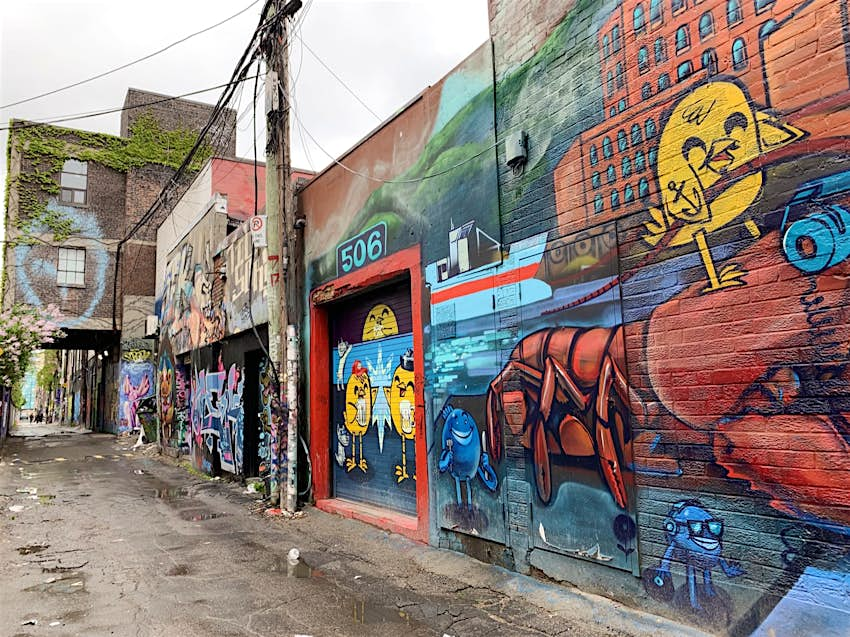
Discover street art
Every neighborhood has a little street art, encompassing everything from graffiti to commissioned murals. Look around and you’ll find examples hidden down forgotten streets in the Financial District, adorning brick walls in the Annex neighborhood and the east end, and covering entire facades in the Village, Kensington Market and the west end.
The most popular – and perhaps the most photographed – location is Graffiti Alley, a collection of myriad artists’ works that spans three blocks just off Queen St West. Highly Instagrammable and perfect for colorful selfies.
St Lawrence Market
Opened in 1845, St Lawrence Market has been part of the city’s fabric for almost 175 years. It’s a foodies’ paradise, with more than 120 vendors selling fresh produce, meats, cheeses and all manner of prepared foods at South Market. Come here to poke around and to graze. Weekends bring the farmers and antique markets, and both are worth checking out.
Inside the old council chambers upstairs, the Market Gallery has rotating displays of paintings, photographs, documents and historical relics, while next door, cooking workshops and special events are held at the Market Kitchen.
Hockey Hall of Fame
The mecca of Canada’s national sport, the Hockey Hall of Fame is a spectacular labyrinthine museum in the Financial District. Inside, multimedia exhibits showcase the greats – icons and players of the game. Visitors walk through a recreated Montréal Canadiens’ locker room, watch documentaries and movies, and even shoot pucks at video-projected National Hockey League goalies.
Even those unfamiliar with the rough, super-fast sport are likely to be impressed by the world’s largest collection of hockey memorabilia. Don’t miss the goalie-mask wall, with rows and rows of personalized face shields. And, of course, be sure to take a pic with the beloved Stanley Cup, the championship trophy awarded annually to the NHL playoff winner.
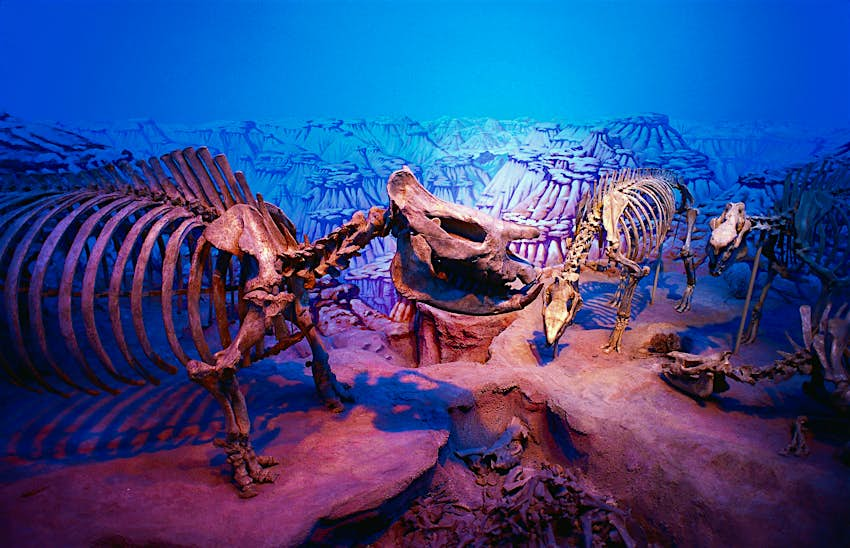
Royal Ontario Museum
Opened in 1914, the multidisciplinary Royal Ontario Museum is Canada’s biggest natural history museum. The permanent collection features more than six million specimens and artifacts, divided between natural history galleries and world culture galleries.
There’s also a ‘discovery zone’ where kids can handle skulls, pelts and stuffed wild animals. Free docent-led tours are offered daily, and you can expect to learn about everything from ice-age mammals and hardwood forests to Chinese temples and religious masks.
Distillery District
Once the Gooderham and Worts distillery, the largest distillery in the British Empire, the Distillery District is now a fabulous collection of restaurants and coffee shops, art studios and galleries, performance spaces and specialty boutiques. The setting is a beautifully preserved Victorian industrial complex – think red brick, cobblestone walkways and imposing buildings.
In summer, expect live jazz, activities, exhibitions and foodie events. In winter, a festival of lights and a Christmas market lure people out from the warmth. Year-round, the place is buzzing.
Art Gallery of Ontario
One of the country’s finest museums, the Art Gallery of Ontario has a wide collection ranging from 15th-century European art to contemporary American works. The highlights are the Canadian pieces, including Inuit and other aboriginal sculptures and paintings and landscapes by Tom Thompson and the Group of Seven – a famous group of Canadian landscape painters from 1920 to 1933.
And, of course, the spectacular redesign of the building itself by renowned Canadian architect Frank Gehry is a treat by itself. There’s a surcharge for special exhibits, but visits to the permanent collection on Wednesday evenings are free. Several highly recommended – and free – tours are offered throughout the week.
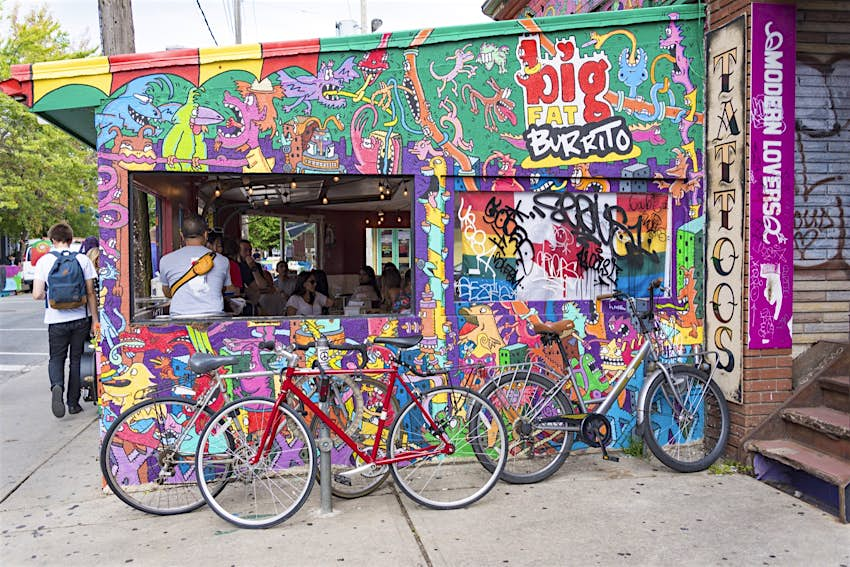
Kensington Market
A relatively small enclave north of downtown, Kensington Market is multicultural Toronto at its most interesting. It’s not a constrained market as much as a working residential neighborhood. The antics in Bellevue Square Park tell you all you need to know about this eccentric – some say just plain weird – area. Yes, there’s a swing set, but it’s literally child’s play compared to the bongo drumming circles, tightrope walking, fire hula-hooping and occasional boomerang tossing that keep the big kids busy.
If you pop along, you’ll find flavors from around the world, pocket-size stores selling vintage books and clothing, bikers and dreadlocked urban hippies. These co-exist happily alongside residential houses, eateries and traditional shops like butchers, greengrocers, fishmongers and cheese merchants.
Biking on the Toronto Islands
For great cycling adventures, head to the serene Toronto Islands, an archipelago of 15 islands with quiet neighborhoods, pleasant beaches, vehicle-free roads and lakefront paths – an unexpected treat in a city of almost six million people.
Bike from beach to beach, explore the different islands – several are connected by bridge – and stop for a snack with a spectacular view. Bikes can be rented on-island at Toronto Islands Bicycle Rental or brought from the mainland. The islands are only accessible by ferry, and the 15-minute trip reveals some of the best skyline views in the city.
Edwards Gardens
In the district of North York, this former estate garden features annuals, wildflowers, peaceful waterfalls and extensive rockery as it sits along Toronto’s ravine system. The arboretum has been magnificently installed next to the Children’s Teaching Garden, allowing toddlers and little ones to interact with the environment.
Adjacent to the park is the Toronto Botanical Gardens. More than 3.7 acres of land make up 17 unique gardens like the Pollinator Garden with Urban Bee Hives, the Kitchen & Herb Garden and the striking Carpet Beds, which hold 15,000 plants and carry on the tradition of Victorian carpet bedding.
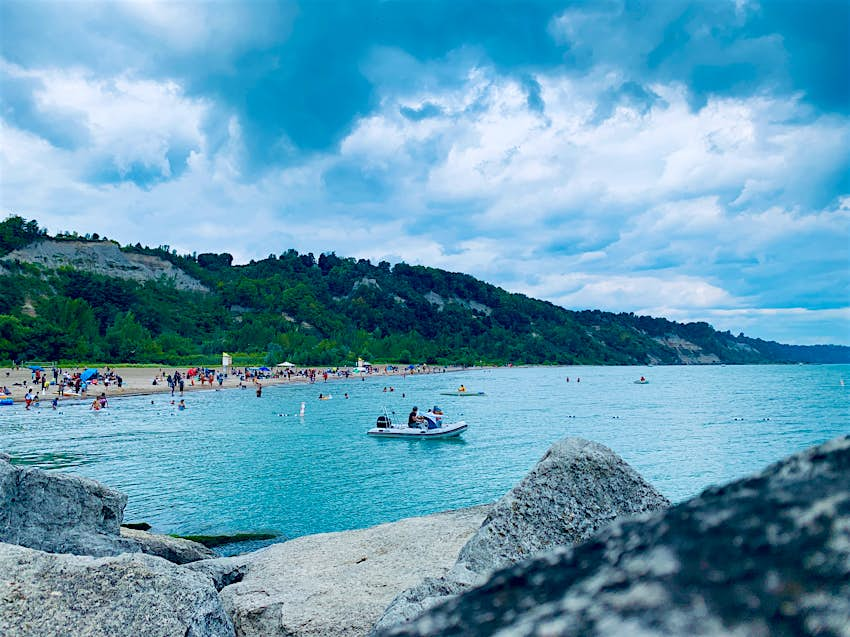
Scarborough Bluffs
For stunning outdoor views, head to Scarborough Bluffs where lakeshore cliffs with cathedral-spire formations expose evidence of five glacial periods. Spanning 14km from Rosetta McClain Gardens to East Point Park, there are several trails that allow visitors to enjoy meadows, forests, beaches, wetlands and spectacular views across Lake Ontario.
The highest section, grassy Cathedral Bluffs Park (65m), makes a great photo op. About 6km east is Guild Park, a serene 36-hectare lakefront forest filled with architectural relics and sculptures from the 1950s to the 1970s. The bluffs also created one of the best beaches in Toronto, Bluffer’s Park Beach, which has soft sand, shallow water and a couple of good swimming spots. It’s also the best place to appreciate the jutting cliffs and spires.
Legoland Discovery Centre
It may not be a full-fledged theme park, but Legoland Discovery Centre is loved by kids. It especially appeals to younger ones, who delight in its collection of hands-on, educational Lego-centric attractions, including an earthquake table, a 4D cinema and a Lego factory.
Located a 30-minute drive northwest from Toronto’s downtown, the attraction has two children’s rides and three million bricks – enough to keep young hands busy for the day. There’s a themed café with family-friendly selections, and the locale is part of a large shopping mall, adding extra appeal for parents who might want some retail therapy after the family excursion.
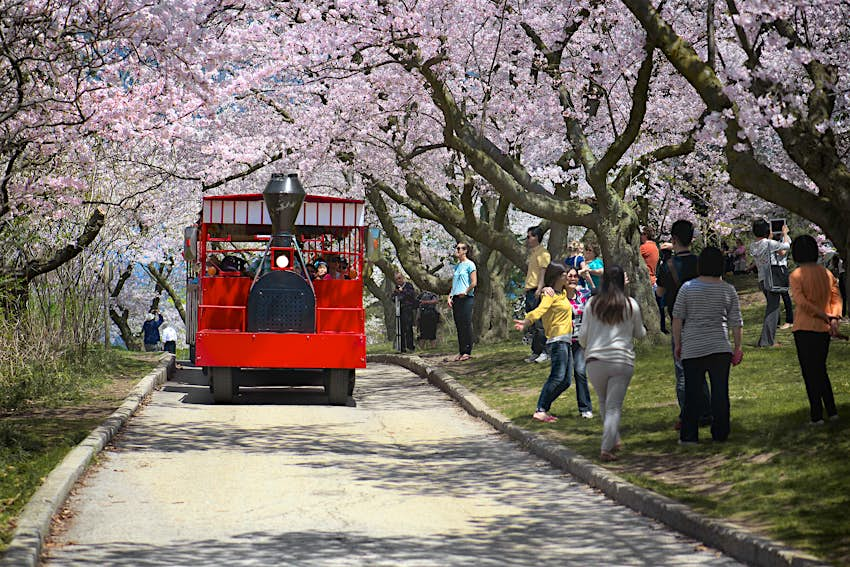
High Park
Located west of downtown Toronto, High Park spans more than 398 acres. The family-friendly park has a playground, public pool, picnic areas, off-leash dog space and sports facilities, and is known for its famous cherry blossoms, which bloom in April and May.
Numerous trails and nature walks can be taken in the summer, and in winter, the park is covered in a white blanket of snow that makes cross-country skiing a beloved activity. The park’s Grenadier Pond is a popular fishing spot and when it freezes over, it’s used for skating. One popular attraction is Shakespeare in High Park, which has been produced in the park’s amphitheater every summer for almost 40 years.
Go to a festival
Toronto plays host to great annual festivals, including Toronto Fringe Festival, which offers more than 150 productions over two weeks in early July. Jazz, blues and soul blaze in Toronto’s streets, nightclubs and concert halls during the Toronto Jazz Festival in late June, when more than 1500 musicians entertain across the city.
Music-lovers can safely write off 10 days in mid-June for the North by Northeast festival, where a plethora of indie bands and comedy acts perform at some of Toronto’s coolest venues, including nontraditional ones such as streetcars and ferries. Then there’s Luminato, an international arts festival dedicated to performance, media and visual arts. It takes place in venues across Toronto each June in a celebration of creativity that reflects the city’s diversity.
Explore Toronto’s food scene
Toronto has more than 7000 restaurants, representing a phenomenal range of tastes, cultures and experiences. Each neighborhood has its own trademark: the Financial and Entertainment Districts have fine dining and celebrity chefs, while Kensington Market and Chinatown are all about hole-in-the-wall eats and homegrown talent. Dining halls featuring a variety of cuisines and communal tables have popped up around town. Assembly Chef’s Hall is a fine place to start.
There are two festivals that showcase Toronto’s culinary scene annually – Summerlicious in July and Winterlicious in January. Over 200 top restaurants participate in these extravaganzas, offering high-end dinner and lunch options in three price categories to showcase the city’s culinary diversity.
Admire architecture
Well-informed volunteers from the Royal Ontario Museum lead ROMWalks, one- to two-hour historical and architectural walking tours taking in some of the city’s lesser-known but most interesting buildings and neighborhoods. Most, but not all, walks are free.
Over the fourth weekend of May, several public and private buildings of architectural and historical significance take part in the Doors Open Toronto event, allowing visitors to sneak a free peek at what’s hot and what’s not in other people’s digs. Book ahead for walking tours and big-name buildings such as City Hall and Union Station.
Harbourfront Centre
The heart of the Waterfront district is the Harbourfront Centre, a cultural megastar made up of more than two dozen waterfront venues, including parks, outdoor stages, theaters and galleries.
An artistic powerhouse, this 4-hectare complex educates and entertains through a variety of year-round performances, events, festivals and exhibits. The main building houses the well-respected Craft & Design Studios, where the public can watch artists-in-residence at work.

Bata Shoe Museum
Shoe-lovers know that it’s important in life to be well-shod, which is a stance the Bata Shoe Museum takes seriously. Impressively designed by Raymond Moriyama to resemble a stylized shoebox, the museum houses a collection of 13,000 ‘pedi-artifacts’ from around the globe spanning 4500 years; only 3% to 4% are on view at any given time.
Peruse 19th-century French chestnut-crushing clogs, Canadian indigenous polar boots or famous pairs worn by Justin Timberlake and Pablo Picasso. Some of the museum’s most famous shoes are ballroom slippers worn by Queen Victoria, Elton John’s monogrammed silver and red platform boots, Elvis Presley’s white and blue patent loafers, Marilyn Monroe’s red leather stilettos, Madonna’s platform Dolce & Gabbanas and the Dalai Lama’s flip flops.
Rogers Centre
Sports fans may want to check out the Rogers Centre, one of the largest stadiums in Canada with over 53,000 seats. Technically awe-inspiring, it opened in 1989 with the world’s first fully retractable dome roof primarily to serve as a baseball stadium for the Toronto Blue Jays.
Tours include a brain-scrambling video wall screening footage of past sporting glories, concerts and events, and you can also check out the stadium’s memorabilia museum.
McMichael Canadian Art Collection
The McMichael Canadian Art Collection is a major public gallery devoted to collecting the art of Canada. Handcrafted buildings set amid 40 hectares of conservation trails contain works by the Group of Seven, as well as by First Nations, Inuit, Métis and other acclaimed Canadian artists.
It’s a 34km drive from Toronto and totally worth the trip. A sculpture garden and the graves of gallery co-founders Robert and Signe McMichaels and six of the Group of Seven artists are also on-site. Free tours are included with admission Wednesday through Sunday.
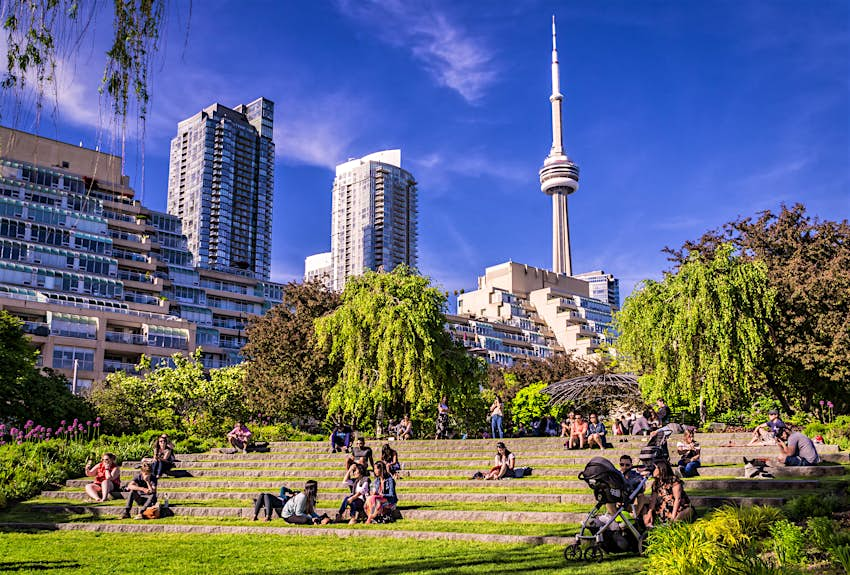
Toronto Music Garden
Toronto Music Garden is one of the city’s most magical locations on the waterfront, designed in collaboration with cellist Yo-Yo Ma. The landscape expresses Bach’s Suite No 1 for Unaccompanied Cello, from the Prelude – conveying the feeling of a river flowing through a stream – to the Gigue – inspired by an English dance where spirited music is interpreted as a series of giant grass steps that offer harbor views.
Design features include the arc-shaped grove of conifers, a swirling path through a wildflower meadow and an outdoor amphitheater where free classical performances are given.
Casa Loma
Toronto’s only castle may never have housed royalty, but Casa Loma certainly has grandeur, lording over the Annex neighborhood from a cliff that was once the shoreline of the glacial Lake Iroquois. You may have seen it in various movies including X-Men, The Pacifier and Chicago.
The 98-room mansion – an architectural hurricane of castellations, chimneys, flagpoles, turrets and Rapunzel-esque balconies – was built between 1911 and 1914 for Sir Henry Pellatt, a wealthy financier. A self-guided audio tour will lead you through the four levels of the Edwardian mansion as well as the 800ft tunnel to the stables, and the top floor houses a military museum.
Pride Toronto
Toronto’s most flamboyant event celebrates the diversity of sexuality and gender identity, with a whole month of community events, workshops and gatherings, most of which are free. There are numerous individual events, party collectives and two festival weekends, with everything based around community, education and celebration.
The festival culminates with the Trans March, Dyke March and Pride Parade events at the end of June, when the streets around Church and Wellesley heave with over a million revelers.
![shutterstockRF_145000603]4.jpg Canada's Wonderland Amusement Park in Toronto](https://lp-cms-production.imgix.net/2021-06/shutterstockRF_1450006034.jpg?auto=format&fit=crop&sharp=10&vib=20&ixlib=react-8.6.4&w=850)
Canada’s Wonderland
Amusement-park lovers will want to trek to Canada’s Wonderland, located 25 miles north of Toronto. It features more than 200 attractions, including 17 rollercoasters, two children’s areas and a 20-acre water park called Splash Works.
Wonder Mountain is the park’s centerpiece and is 150 feet high at its tallest peak, with a 60-foot high waterfall. If you have the nerve, check out Leviathan, the tallest and fastest rollercoaster in Canada with a summit that reaches a height of 93.3m.
Heritage Toronto
Heritage Toronto provides a diverse offering of fascinating historical, cultural and nature walks and bus tours. Led by museum experts, neighborhood historical-society members and emerging historians, they take visitors through parks, to well-known landmarks, and through the many neighborhoods that make up Toronto.
Tours aim to commemorate the city’s rich heritage and the diverse stories of its people, places and events. The website also offers a handful of downloadable self-guided tours.
